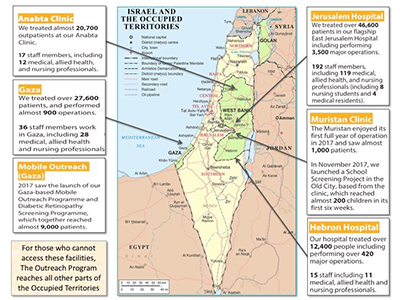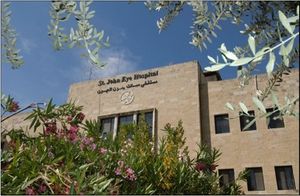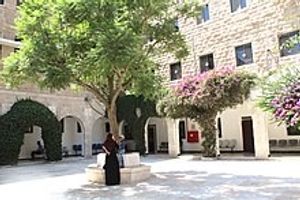Palestine, one of the most vulnerable and impoverished populations in the world, is getting the benefit of essential ophthalmic care from The St. John Eye Hospital Group (SJEHG).
What is surprising is that this hospital group has provided care in the Middle East for almost 140 years in an area where no universal national health service exists. The group treats all patients irrespective of race, religion or ability to pay. It has the backing of the Order of St. John Priory in the U.S. and all other priories and improves the well-being of men, women and children in this difficult part of the world.
History
The Most Venerable Order of the Hospital of St. John of Jerusalem has its origins in the early 11th century. Led by the Blessed Gerard, the holy order of Religious Hospitallers assumed responsibility for a hospice for pilgrims. It was built upon the legacy of the Amalfi traders and their Persian predecessors, who oversaw an ancient hospital on the site 200 years earlier. By the end of the 11th century, the hospital had 1,000 beds and treated up to 2,000 male and female patients at times of conflict, irrespective of race, religion or social status.
Pope Paschal II established the order by papal charter in 1113 under the patronage of St. John the Baptist. In 1144, the British Knights of the Order of St. John established a priory in Clerkenwell, London where, despite the dissolution of the monasteries in the reign of Henry VIII, the headquarters of St. John remains to this day

It remains a Roman Catholic institution, led by its own Prince Grand Master (with cardinal’s rank) and in indirect obedience to the Holy See. The Sovereign Military Order of the Hospital of St. John of Jerusalem, of Rhodes, and of Malta, also known as SMOM or the Order of Malta, has over 18,000 members and a few thousand non-member auxiliaries worldwide.
Despite denominational differences, the Roman Catholic order (SMOM) and the four Protestant orders (British, German, Dutch and Swedish) recognize each other as legitimate Orders of St. John and support each other’s efforts.
To this day, most run hospitals, first responder or ambulance services and care for the sick and the poor. However, all reference to the order relate to the British Venerable Order of St. John, or, to give it its full title, The Most Venerable Order of the Hospital of Saint John of Jerusalem. With its global headquarters in Clerkenwell, London, it remains a royal Order of Chivalry.
In 1882, soon after its foundation, the Order of St. John established an eye hospital in Jerusalem, chiefly to deal with trachoma, previously known as the “Mesopotamian Scourge” and “Egyptian ophthalmia.” Built on the road to Hebron close to the walls of the Old City, the hospital would see and treat all patients irrespective of their background or wealth. It reflects the order’s ethos born in Jerusalem some eight hundred years earlier and embodied in its new motto, “Pro Fide, Pro utilitatis hominum,” which means “For the Faith, for the service of Mankind.”
The order’s flagship hospital was founded in Jerusalem, with the St. John Ambulance Brigade following soon thereafter in 1887. Today, the order is an active humanitarian charity with a single mission: To prevent and relieve sickness and injury and to act to enhance the health and well-being of people anywhere in the world.
Current Organization
St. John is a serving Order of Chivalry of the British Crown and is formed of 11 priories across the world, and numerous smaller St. John associations. Membership, bestowed by warrant of its sovereign head, Her Majesty Queen Elizabeth II, includes persons of all faiths who espouse the essential Christian principles of charity to all in need, irrespective of race, religion or political persuasion. The order’s Grand Prior is His Royal Highness Prince Richard, Duke of Gloucester, a Knight of the Order of the Garter and Knight Grand Cross of the Royal Victorian Order.
Although the U.S. priory was officially established in 1996, its history began some 40 years earlier, in 1957, and has since grown to include over 1,600 members.
The order's members, known as confrères, are mostly of the Protestant faith. However, those of other Christian denominations or other religions, including the Jewish faith, are welcomed into the order. Membership is generally by invitation only. Individuals may neither petition nor pay for admission. The organization is a constituent member of the Alliance of the Orders of St. John of Jerusalem, a registered charity under English law, and a non-profit charity in the United States.
In 2015, an academic arm was established to support the hospital group. Called the St. John Ophthalmic Association (SOA), this new body includes ophthalmologists and healthcare professionals across four continents representing all 11 priories. (Learn more at www.SOA.global).

The priory’s main focus is to support the St. John of Jerusalem Eye Hospital Group. The group has evolved to meet the ever-growing demand for eye care in the region and now operates from its main hospital in Jerusalem, a clinic in the Anabta in the north of the West Bank, a hospital in Hebron in the south and the recently opened flag-ship hospital in Gaza. Supported by its priories and numerous donors, the hospital group treats over 135,000 patients a year suffering with eye disease and at risk of becoming blind.
Grades of the Order of St. John |
|
|
V
|
IV
|
III
|
II
|
I
|
|
Member
|
Officer
|
Commander
|
Knights/Dames of Justice or Grace
|
Bailiff/Dame Grand Cross
|
|
MStJ
|
OStJ
|
CStJ
|
KStJ/DStJ
|
GCStJ
|
Depending on length and depth of service, members of St. John may ascend through the grades from V to I, as shown above. The statutory maximum for knights and dames is 4 percent. The grade of bailiff/dame Grand Cross is reserved for the highest officers or royalty.
These promotions exist to recognize performance over and above that which might ordinarily be expected of a person in a particular role, including distinguished leadership or for a high level of specialist contribution. It requires documentation and recommendations from the prior to the queen. This is in contrast with the knighthood given directly by the queen to a British citizen, which is a state honor awarded by the queen. With St. John, the queen acts in her capacity as sovereign head of the order and not the state.
I was invested into the order in 2000. I worked my way up the ranks and became a knight in 2014. I now serve as a member of the chapter (board) of the American priory. A knight or dame of St. John are allowed their own coat of arms. I worked with the heraldry in London and created one. This allows one to move from a Knight of Grace to a Knight of Justice.
The president-elect of the Academy, Anne Coleman, is the Hospitaller of the American priory.
United States
As one of 11 priories of the Order of St. John, the priory in the United States of America is led by a prior and a chapter (board). The priory chapter is made up of 20 members of the order from across the U.S. who serve staggered three-year terms.
The regional administration of U.S. priories is divided into 19 geographic areas. As of 2018, these regions were Atlanta; Austin, Texas/San Antonio; Birmingham, Ala.; Charleston, S.C.; Greenwich, Conn.; Connecticut; the Gulf Coast; Houston, Texas; Massachusetts; the Mountain States; New York; North Carolina; Palm Beach, Fla.; Richmond, Va., San Diego; San Francisco; Southwest (Dallas); St. Louis; and Washington, D.C.
Unlike many other priories and associations of the Order of St. John, the priory in the U.S. does not manage an ambulance service for first aid training and first aid cover. Thus, and to the enormous benefit of the hospital group, the chief focus of the priory has always been to raise funds for the order’s eye hospitals in Jerusalem, the West Bank, and Gaza. So effective is this support that the priory’s annual donation is the largest of all priories and other donors.

St. John of Jerusalem Eye Hospital Group's Main Hospital in Sheik Jarrah
St John Eye Hospital Group
The original hospital was founded by the Order of St. John in 1882 on the Bethlehem Road, and was granted a Royal Charter by Queen Victoria. Sir Edmund Lechmere, 3rd Baronet of Hanley Castle, Worcestershire, was one of the key figures in the foundation of the Venerable Order of St. John. He and his wife travelled to Jerusalem on several occasions where they witnessed first-hand the urgent need for healthcare among its citizens.
Jerusalem Hospital
The main Jerusalem hospital lies a mile north of the Old City Walls in a region of East Jerusalem called Sheik Jarrah. It was built in 1960 and is the largest of all St. John’s eye units. It is ISO- and Joint Commission International-accredited, with several wards staffed by locally trained nurses, doctors and allied health professionals.
There are several subspecialty outpatient departments, including dedicated paediatric, retinal and corneal clinics and care in all but one subspecialty within ophthalmology (oncology) is provided by the hospital group.
The hospital also has a research unit, primarily focused on genetics, since there is considerable consanguinity in the Palestinian population. Diabetes is described as high as 40 percent in the population, and the hospital group is actively engaged in population-based retinal screening programs. The hospital attracts volunteer doctors from around the world who not only help care for the patients, but also contribute towards the hospital’s postgraduate activities, with significant support for these, and the SOA, coming from the priory in the US.
There is also a strong and valued partnership with colleagues in the medical genetics and ophthalmic departments of the Hadassah Hospital. Our colleagues in West Jerusalem have for decades contributed to both the ophthalmic training of the hospital group doctors and their postgraduate development.

The Hospital Cloisters
The Gaza Hospital
St. John Gaza Hospital has provided charitable eye care for the 1.8 million residents of Gaza since 1992. In June 2016, St. John opened a new state-of-the-art hospital in Gaza, where over 27,000 patients were treated in 2017, and 900 major operations performed. The hospital project received substantial Qatari, Norwegian, United Nations, International Medical Corps IMC and USAID support.
Hebron Hospital
In 2005, in response to the growing movement restrictions in the West Bank, the hospital group set up a hospital in Hebron. The hospital provides cataract and laser eye surgery to treat diabetic retinopathy, and serves the 640,000 people that live in and around Hebron, including the semi-nomadic Bedouins of the Negev Desert. In November 2015, the hospital group moved into a new Hebron hospital, and in 2017, the hospital treated over 12,400 patients, including performing over 420 major operations.

The St. John Hebron Hospital
Anabta Clinic
In 2007, the hospital group set up its clinic in Anabta in the north of the West Bank, where over 20,700 patients are treated each year. The clinic is easily accessible from the major areas of Nablus, Tulkarem and Jenin.
Mobile Outreach Programs
The Mobile Outreach Program was launched in 1980. It has two teams which travel across the West Bank every week. One Mobile Outreach team typically sees between 8,000 and 10,000 Palestinians each year. Over 16,000 patients were seen in 2017. Finally, a Mobile Outreach Program was launched for the first time in 2017. It went to areas within Gaza, coordinated from the new Gaza hospital.
Author’s note: I want to gratefully acknowledge the advice and information provided by David Verity and James Terzian, both officers of the Order of St. John, in preparing this article.
About the author: Dr. Spivey, MD, MS, MEd, is a Knight of St. John and member of the St. John Ophthalmic Association (SOA).